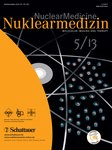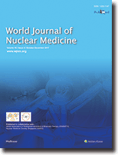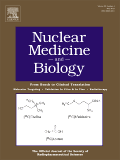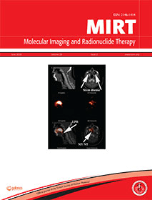
American Journal of Nuclear Medicine and Molecular Imaging
Scope & Guideline
Dedicated to the Evolution of Nuclear Medicine and Imaging Science
Introduction
Aims and Scopes
- Nuclear Medicine Applications:
Research on the development and clinical application of radiopharmaceuticals for diagnostic and therapeutic purposes, including novel tracers and their implications for various diseases. - Molecular Imaging Techniques:
Exploration of advanced imaging modalities such as PET, SPECT, and MRI, focusing on improvements in imaging quality, quantification methods, and the integration of multimodal imaging. - Cancer Diagnosis and Management:
Emphasis on the role of nuclear medicine and molecular imaging in oncology, including tumor characterization, staging, treatment response evaluation, and prognostic indicators. - Cardiovascular Imaging:
Investigation into the use of nuclear imaging techniques in assessing cardiovascular diseases, including myocardial perfusion and inflammation. - Artificial Intelligence in Imaging:
Integration of artificial intelligence and machine learning in imaging analysis, aimed at enhancing diagnostic accuracy, automated detection, and predictive modeling.
Trending and Emerging
- Radiomics and Quantitative Imaging:
An increasing number of studies are incorporating radiomics, where quantitative features are extracted from imaging data to enhance tumor characterization and predict treatment outcomes. - Theranostics:
The integration of therapeutic and diagnostic approaches, particularly in cancer treatment, has gained traction, with more papers focusing on the development of theranostic agents. - AI and Machine Learning Applications:
The use of artificial intelligence and machine learning algorithms to improve imaging analysis, enhance diagnostic capabilities, and streamline workflows is rapidly growing. - PET/MRI Hybrid Imaging:
Research on hybrid imaging techniques, particularly PET/MRI, is becoming more prominent as this combination offers advantages in soft tissue contrast and functional imaging. - Personalized Medicine in Imaging:
There is a notable shift toward personalized medicine, with studies focusing on tailoring imaging techniques and radiotracers to individual patient characteristics for optimal outcomes.
Declining or Waning
- Traditional Imaging Modalities:
There is a noticeable reduction in publications focusing solely on traditional imaging techniques without integration of newer technologies or methodologies, as the field shifts towards hybrid and multimodal approaches. - Basic Science Studies:
The journal has seen fewer papers centered around basic science research in nuclear medicine, indicating a trend towards more clinically relevant and applied research. - Invasive Diagnostic Techniques:
Research related to invasive diagnostic methods is declining, as non-invasive imaging techniques gain prominence and improve in sensitivity and specificity. - Historical Reviews:
The frequency of historical reviews or discussions on the evolution of nuclear medicine practices has decreased, with a stronger focus on current innovations and future directions.
Similar Journals

NUKLEARMEDIZIN-NUCLEAR MEDICINE
Transforming Healthcare through Nuclear Medicine Discoveries.NUKLEARMEDIZIN-NUCLEAR MEDICINE is a prestigious journal published by Georg Thieme Verlag KG, focusing on pivotal advancements in the fields of Nuclear Medicine, Radiology, and Imaging. Established in 1959, this journal has served as a critical platform for disseminating innovative research, reviews, and clinical guidelines until its anticipated convergence in 2024. With an ISSN of 0029-5566 and an E-ISSN of 2567-6407, NUKLEARMEDIZIN is acknowledged in the academic community as a Q3 category journal within Medicine (miscellaneous) and Radiology, Nuclear Medicine, and Imaging as of 2023, highlighting its ongoing contribution to the interdisciplinary dialogue in healthcare. Although the journal does not currently offer open access, it remains accessible to professionals and students through various academic databases, ensuring that cutting-edge knowledge in this growing field is shared widely. Researchers interested in the latest methods and technologies in Nuclear Medicine will find NUKLEARMEDIZIN a valuable resource for enhancing their work and understanding the complexities of modern imaging modalities.

NUCLEAR MEDICINE REVIEW
Connecting Researchers to Transformative Medical KnowledgeNUCLEAR MEDICINE REVIEW is a distinguished journal in the field of radiology, nuclear medicine, and imaging, published by VIA MEDICA in Poland. Since its transition to an open access format in 1999, this journal has been dedicated to promoting the dissemination of knowledge and research findings across a global audience. With a focus on innovative approaches and advancements in nuclear medicine, it aims to serve as a key resource for researchers, professionals, and students who are working to further the understanding of nuclear imaging and its applications. In 2023, the journal was classified in the Q3 category within Radiology, Nuclear Medicine and Imaging, and Q4 in the broader category of Medicine (miscellaneous), highlighting its growing reputation in the academic community. As of the latest assessments, the journal has been ranked #235 out of 333 in its field according to Scopus metrics, reflecting its commitment to excellence and the relevance of its published works. The NUCLEAR MEDICINE REVIEW is a pivotal platform for those engaged in cutting-edge research, providing insights that drive the evolution of medical imaging and therapeutic techniques.

World Journal of Nuclear Medicine
Unlocking the Potential of Nuclear Medicine for AllWorld Journal of Nuclear Medicine, published by THIEME MEDICAL PUBL INC, is a premier peer-reviewed journal dedicated to advancing the field of nuclear medicine. With an Open Access model established since 2011, this journal ensures that high-quality research is accessible to a wide audience, fostering knowledge sharing and collaboration among researchers, clinicians, and students alike. The journal aims to publish innovative studies, reviews, and clinical trials that contribute significantly to both the theoretical and practical aspects of nuclear medicine, enhancing diagnostic and therapeutic techniques within this critical area of healthcare. As the journal continues to grow in visibility and impact, it remains an essential resource for those seeking to stay at the forefront of advancements in nuclear medicine.

ANNALS OF NUCLEAR MEDICINE
Elevating Standards in Nuclear Medicine ScholarshipANNALS OF NUCLEAR MEDICINE is a prominent academic journal dedicated to the field of nuclear medicine, published by Springer. With a rich publication history dating back to 1987 and continuing through 2024, this journal serves as a vital resource for researchers and practitioners interested in the latest developments in nuclear imaging, radiopharmaceuticals, and therapeutic applications. Ranked in the second quartile (Q2) for both Medicine (miscellaneous) and Radiology, Nuclear Medicine, and Imaging categories in 2023, it maintains a strong position in the academic community, with an impressive Scopus rank of #104 out of 333 in its field, placing it in the 68th percentile. The journal is not open access but offers a range of access options through institutional or individual subscriptions, ensuring that critical research findings reach a wide audience. By fostering high-quality, peer-reviewed articles, ANNALS OF NUCLEAR MEDICINE plays a crucial role in advancing the understanding and practical application of nuclear medicine techniques, making it an essential journal for professionals and students aiming to stay at the forefront of this evolving discipline.

NUCLEAR MEDICINE AND BIOLOGY
Exploring innovative applications of nuclear techniques.NUCLEAR MEDICINE AND BIOLOGY, published by Elsevier Science Inc, is a premier journal dedicated to advancing the fields of nuclear medicine and molecular biology. Since its inception in 1986, this journal has served as a vital platform for the dissemination of high-quality research, with a clear focus on the innovative applications of nuclear techniques in biological settings. It is categorized in the Q3 tier for both Cancer Research and Molecular Medicine, and Q2 for Radiology, Nuclear Medicine and Imaging, highlighting its significant standing within these disciplines. The journal's Scopus rankings reflect its strong impact, placing it in the top quartile of its categories, particularly in Radiology, Nuclear Medicine, and Imaging. Researchers, professionals, and students alike will find this an invaluable resource for contemporary research findings and methodologies in nuclear medicine and its biological applications. Access to the journal is provided through subscription, ensuring that quality content remains available to its wide-ranging audience.

Radiology-Imaging Cancer
Illuminate the Future of Oncology with Cutting-Edge Radiology.Radiology-Imaging Cancer is a prestigious journal published by the Radiological Society of North America (RSNA), focusing on the critical intersection of radiology, oncology, and advanced imaging techniques. This journal stands out in its field with a commendable ranking in the Q2 category for Medicine (miscellaneous) and Oncology, and an impressive Q1 ranking in Radiology, Nuclear Medicine and Imaging, according to the 2023 quartiles. With an ISSN of 2638-616X, it serves as an essential platform for the dissemination of research that contributes to the understanding and improvement of cancer diagnosis and treatment. Its comprehensive scope encompasses a range of topics, from innovative imaging modalities to clinical applications in oncology, making it a valuable resource for researchers, clinicians, and students interested in the evolving field of cancer imaging. Despite being published in the United States, the journal aims for a global reach, catering to a wide audience dedicated to advancing medical science.

Iranian Journal of Radiology
Elevating Diagnostic Imaging with Quality InsightsWelcome to the Iranian Journal of Radiology, a pivotal platform dedicated to advancing the field of radiology, nuclear medicine, and medical imaging. Published by BRIEFLAND, this journal aims to disseminate high-quality original research, reviews, and clinical studies that contribute substantially to the global scientific community. Established in 2008 and spanning until 2024, the journal provides an essential archive of knowledge in a rapidly evolving discipline. Although it currently holds a Q4 quartile ranking in the 2023 Scopus metrics, it serves as an important resource for both emerging and established researchers looking to submit their work. Located in the Netherlands, the journal is committed to open dialogue and collaboration amongst professionals in the field, reflecting its accessibility and relevance to both practitioners and academics. With its continued growth and commitment to quality, the Iranian Journal of Radiology is poised to enhance understanding and innovation in diagnostic imaging.

EUROPEAN JOURNAL OF NUCLEAR MEDICINE AND MOLECULAR IMAGING
Fostering Excellence in Nuclear Medicine ResearchThe European Journal of Nuclear Medicine and Molecular Imaging is a prestigious, peer-reviewed journal published by Springer, dedicated to advancing the field of nuclear medicine and molecular imaging. With an impressive impact factor and ranked in the Q1 category for both Medicine and Radiology, Nuclear Medicine and Imaging, this journal is a pivotal platform for researchers and practitioners to disseminate significant findings from 1996 to the present, reflecting the evolution of the field. The journal boasts a notable Scopus rank, standing at #8 out of 333 in its category, placing it in the top 3% of published works, which highlights its critical importance in shaping contemporary practices and research innovations. Although it does not offer an open-access model, the journal provides various access options to ensure that important research is accessible to professionals, students, and academics alike. Through rigorous peer review and a commitment to high-quality publication, the European Journal of Nuclear Medicine and Molecular Imaging plays an essential role in the advancement of nuclear medicine, contributing to better diagnostic and therapeutic outcomes globally.

Molecular Imaging and Radionuclide Therapy
Innovating the future of nuclear medicine and imaging.Molecular Imaging and Radionuclide Therapy is an esteemed academic journal published by GALENOS PUBL HOUSE, dedicated to advancing the fields of radiology, nuclear medicine, and imaging. Since its inception, this Open Access journal has facilitated the dissemination of high-quality research and innovative practices in molecular imaging and radionuclide therapy, making it a vital resource for researchers, professionals, and students alike. With an ISSN of 2146-1414 and an E-ISSN of 2147-1959, the journal has established its presence globally while specifically catering to the Turkish academic and medical community. As of 2023, it is ranked #241/333 in the Radiology, Nuclear Medicine and Imaging category on Scopus, holding a respectable Q3 quartile ranking. The journal serves as a platform for sharing impactful findings from 2017 to 2024, reinforcing its commitment to open access since 2011. With a dedication to enhancing the knowledge base in molecular imaging and therapy, it remains an important conduit for scholarly communication and collaborative research developments in this dynamic field.

INTERNATIONAL JOURNAL OF CARDIOVASCULAR IMAGING
Elevating Standards in Cardiovascular Imaging ResearchINTERNATIONAL JOURNAL OF CARDIOVASCULAR IMAGING, published by Springer, is a prestigious platform dedicated to the interdisciplinary field of cardiovascular medicine and imaging. With an ISSN of 1569-5794 and E-ISSN 1875-8312, the journal is recognized in both Cardiology and Cardiovascular Medicine (Rank #154/387, Q2 Category) and Radiology, Nuclear Medicine and Imaging (Rank #137/333, Q2 Category) disciplines, reflecting its significant impact within the scientific community. Established in 1988 and continuing to the present, it provides a rigorous forum for cutting-edge research, reviews, and clinical insights that are essential for advancing knowledge in cardiovascular diagnostics and therapeutic imaging. The journal's dual access options cater to both traditional and open-access readership, ensuring wide dissemination of its findings. In an era where cardiovascular diseases pose a significant public health challenge, the INTERNATIONAL JOURNAL OF CARDIOVASCULAR IMAGING stands out as an essential resource for researchers, healthcare professionals, and scholars aiming to innovate and improve patient outcomes through imaging technology.